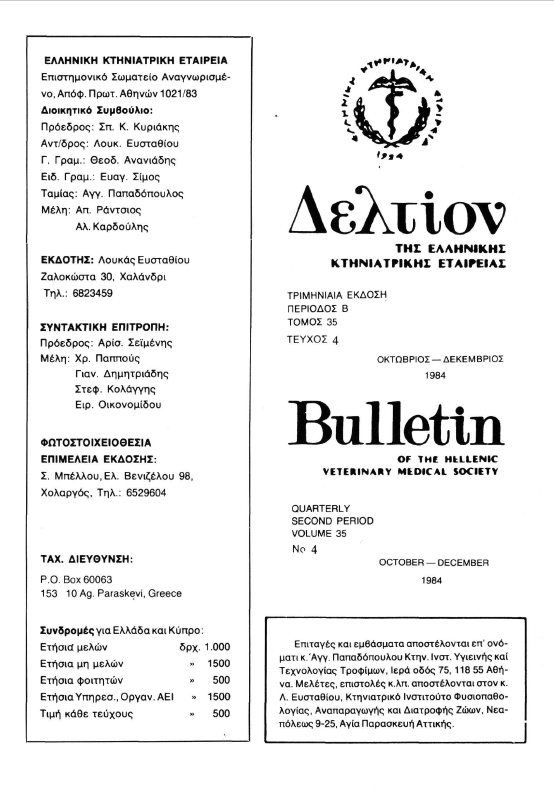Effect of debeaking on the performance of laving hens and on egg shell quality
Abstract
The effect of debeaking at 18 days of age on the performance of layinig hens and egg' s shell strength (quality) was studied during the first stage of laying period (22 to 42 weeks of age). For this study 71 White Leghorns (Babcock Β - 300F) hens were used. Thirty six hens were used as controls (group A) and the remaining 35 were subjected to debeaking (group B). Body weight and feed consumption were measured during the experiment. Number of eggs and the egg weight (individualy) were measured every day. A total of 200 eggs examined with samples of 50 eggs taken randomly on the 28th, 32th, 38th, and 40th week age of hens. In each egg the following characteristics were determined: (a) specific gravity; (b) shell deformation (non destructive); and (c) egg shell crushing strength. The results have been summarised as follows: (1) In the group debeaked, body weight at 32 weeks of age was reduced by 81.39 g per hen (4.78% - P<0.01). Also, the feed consumption throughout the experimental period of 20 weeks, was reduced by 590 grams per hen (4.15% - P< 0.05) and the feed efficiency was better by 0.03 units. (2) Debeaking had no significant effect on egg production traits, althought the debeaked hens laid less eggs (3 eggs/hen) Jhan controls. Also, the debeaked hens laid smaller eggs than hens of control group. The difference of 0.28 g per egg was no significant. (3) Debeaked hens produced eggs with less specific gravity, shell deformation and crushing strength than controls. The differences of -0.005 or 0.46%, -0.31 Mm or 1.03%, -0.02 or 0.76%, respectively, were not significant (P>0.05). (4) In both groups, the specific gravity and the crushing strength of the eggs laid decreaced. Also, the shell deformation, increased as hen's age increased. (5) There was a high negative correlation between shell deformation and specific gravity (P 0.05) and crushing strength (P< 0.01). From this study is concluded that (a) the debeaking at 18 days of age causing in a slight but not significant reduction of egg production during the first stage of laying period. This reduction in economic terms is counder balanced by the increased feed efficiency and reduction of losses due to cannibalism. and (b) debeaking had no any effect on strength (quality) of egg shell
Article Details
- How to Cite
-
Γιαννακόπουλος Α. (2019). Effect of debeaking on the performance of laving hens and on egg shell quality. Journal of the Hellenic Veterinary Medical Society, 35(4), 255–265. https://doi.org/10.12681/jhvms.21662
- Issue
- Vol. 35 No. 4 (1984)
- Section
- Articles

This work is licensed under a Creative Commons Attribution-NonCommercial 4.0 International License.
Authors who publish with this journal agree to the following terms:
· Authors retain copyright and grant the journal right of first publication with the work simultaneously licensed under a Creative Commons Attribution Non-Commercial License that allows others to share the work with an acknowledgement of the work's authorship and initial publication in this journal.
· Authors are able to enter into separate, additional contractual arrangements for the non-exclusive distribution of the journal's published version of the work (e.g. post it to an institutional repository or publish it in a book), with an acknowledgement of its initial publication in this journal.
· Authors are permitted and encouraged to post their work online (preferably in institutional repositories or on their website) prior to and during the submission process, as it can lead to productive exchanges, as well as earlier and greater citation of published work.



